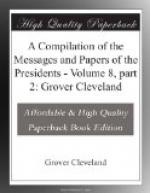In studying, for the purpose of illustration, the history of this part of the boundary line it will be found that a change was made in it by the Quebec act of 1774. The proclamation of 1763 directs the forty-fifth parallel to be continued only until it meets highlands, while in that bill the Connecticut River is made the boundary of the Province of Quebec. Now the earlier of these instruments was evidently founded upon the French claim to extend their possession of Canada 10 leagues from the St. Lawrence River, and from the citadel of Quebec, looking to the south, are seen mountains whence rivers flow to the St. Lawrence. On their opposite slope there was a probability that streams might flow to the Atlantic. These mountains, however, are visibly separated from those over which the line claimed by the United States runs by a wide gap. This is the valley of the Chaudiere; and the St. Francis also rises on the southeastern side of these mountains and makes its way through them. It is not, therefore, in any sense a dividing ridge. Yet under the proclamation of 1763 the Provinces of New York and New Hampshire claimed and were entitled to the territory lying behind it, which is covered by their royal charters. The Quebec act, it would appear, was intended to divest them of it, and according to the construction of the treaty of 1783 now contended for the United States acquiesced in this diminution of the territory of those members of the Union. If, however, it be true, as maintained by Messrs. Featherstonhaugh and Mudge, that the highlands seen to the south of Quebec are a portion of the ridge seen




